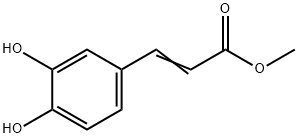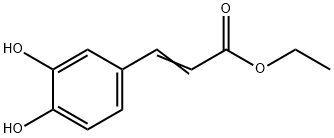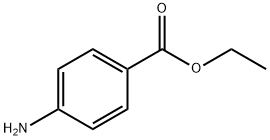Phenethyl caffeate
Synonym(s):Caffeic Acid Phenethyl Ester, Synthetic;CAPE;CAPE - CAS 104594-70-9 - Calbiochem
- CAS NO.:104594-70-9
- Empirical Formula: C17H16O4
- Molecular Weight: 284.31
- MDL number: MFCD00866470
- EINECS: 627-151-0
- SAFETY DATA SHEET (SDS)
- Update Date: 2025-12-25 11:31:46

What is Phenethyl caffeate?
Description
Phenylethyl caffeate is one of the allergens of propolis (bee glue); also contained in poplar-bud secretions.
Chemical properties
Off-White Solid
The Uses of Phenethyl caffeate
antineoplastic, antiinflammatory, immunomodulator, NFkB blocker
The Uses of Phenethyl caffeate
Cytotoxic agent against cancer cell lines. Inhibitor of ornithine decarboxylase and protein tyrosine kinase. Found to be a specific inhibitor of the nuclear transcription factor, NF-kB. It has also been shown to significantly suppress the lipoxygenase pathway of arachidonic acid metabolism during inflammation.
The Uses of Phenethyl caffeate
Phenylethyl 3,4-dihydroxycinnamate is a potent and specific inhibitor of nuclear transcription factor, NF-κB, activation. It has been shown to significantly suppress the lipoxygenase pathway of arachidonic acid metabolism during inflammation. It inhibits HIV-1 integrase and also inhibits proliferation of transformed cells. It induces apoptosis in transformed fibroblasts, and interferes with EGF signal transduction affecting both protein kinase C and ornithine decarboxylase activity.
What are the applications of Application
Caffeic acid phenethyl ester is an inhibitor of ornithine decarboxylase, protein tyrosine kinase and lipoxygenase activities.
Definition
ChEBI: Phenethyl caffeate is an alkyl caffeate ester in which 2-phenylethyl is the alkyl component. It has a role as an antineoplastic agent, an anti-inflammatory agent, an immunomodulator, a metabolite, an antioxidant, a neuroprotective agent, an antiviral agent and an antibacterial agent.
Biological Activity
Antioxidant, antimitogenic, anticarcinogenic, anti-inflammatory and antiviral. Specifically inhibits NF- κ B activation and inhibits the growth of transformed cells. Also suppresses lipid peroxidation and inhibits ornithine decarboxylase, protein tyrosine kinase and lipoxygenase activities.
Contact allergens
Capee is one of the allergens of propolis (bee glue). It is also contained in poplar bud secretions.
Biochem/physiol Actions
CAPE exhibits several properties such as anticarcinogenic, immunomodulatory activities, antioxidant, antiviral, anti-inflammatory, hypoglycaemic effect, cardioprotective and inhibits gastric secretion. It also has an inhibitory effect on fibroblasts growth factor type 2 (FGF-2), a tumor growth factor in breast cancer.
Anticancer Research
Caffeic acid (3,4-dihydroxycinnamic acid) phenethyl ester (CAPE) is a natural phenolcompound and an active component of propolis from honeybee hives. Torkiet al. (2017)investigated the effect of phosphatidylinositol 3-kinase/AKT/mammaliantarget of rapamycin (PI3K/Akt/mTOR) signaling pathway dual inhibitor, NVP-BEZ235,and CAPE on TNBC cell line (MDA-MB-231), stimulated withtransforming growth factor (TGF)-β1 for 14 days. CAPE in combination with NVP-BEZ235synergistically inhibited cell growth and reduced CXCR4 expression.Also, treatment of MDA-MB-231 cells with CAPE and NVP-BEZ235 time-dependentlyinhibited the expression of p-Forkhead Box O3a (FOXO3a). In a nutshell,these results indicate that tumour metastasis and progression in TNBC cellscan be effectively reduced through the concurrent use of NVP-BEZ235 and CAPE(Torki et al. 2017).
Storage
Store at -20°C
References
1) Sudine et al. (1993) Caffeic acid phenethyl ester as a lipoxygenase inhibitor with antioxidant properties. FEBS Lett. 21 329 2) Natarajan et al. (1996) Caffeic acid phenethyl ester is a potent and specific inhibitor of activation of nuclear transcription factor NF-kappa B. Proc. Natl. Acad. Sci. USA 93 9090 3) Chiao et al. (1995). Apoptosis and altered redox state induced by caffeic acid phenethyl ester (CAPE) in transformed rat fibroblast cells; Cancer Res. 55 3576 4) Orban et.al. (2000), Caffeic acid phenethyl ester induces leukocyte apoptosis, modulates nuclear factor-kappa B and suppresses acute inflammation; Neuroimmunomodulation, 7 99
Properties of Phenethyl caffeate
| Melting point: | 127-129℃ |
| Boiling point: | 498.6±45.0 °C(Predicted) |
| Density | 1.266±0.06 g/cm3(Predicted) |
| storage temp. | -20°C |
| solubility | Soluble in ethyl acetate at 50mg/ml. Soluble in DMSO and ethanol. |
| form | White to off-white solid |
| pka | 8.46±0.20(Predicted) |
| color | off-white |
| Sensitive | Light Sensitive |
| λmax | 323nm(lit.) |
| Stability: | Stable for 2 years from date of purchase as supplied. Solutions in DMSO or ethanol may be stored at -20° for up to 1 month. |
| CAS DataBase Reference | 104594-70-9(CAS DataBase Reference) |
Safety information for Phenethyl caffeate
| Signal word | Warning |
| Pictogram(s) |
 Exclamation Mark Irritant GHS07 |
| GHS Hazard Statements |
H315:Skin corrosion/irritation H319:Serious eye damage/eye irritation H335:Specific target organ toxicity, single exposure;Respiratory tract irritation |
| Precautionary Statement Codes |
P261:Avoid breathing dust/fume/gas/mist/vapours/spray. P304+P340:IF INHALED: Remove victim to fresh air and Keep at rest in a position comfortable for breathing. P305+P351+P338:IF IN EYES: Rinse cautiously with water for several minutes. Remove contact lenses, if present and easy to do. Continuerinsing. P405:Store locked up. |
Computed Descriptors for Phenethyl caffeate
| InChIKey | SWUARLUWKZWEBQ-VQHVLOKHSA-N |
Phenethyl caffeate manufacturer
New Products
Indole Methyl Resin tert-butyl 9-methoxy-3-azaspiro[5.5]undecane-3-carboxylate Boc-His(Boc)-OH 2-CTC Resin 4-Chloro-7-tosy1-7Hpyrrolo[2,3-d]pyrimidine 5,7-Dibromo-1H-indole 2,5-dichloro-N-hydroxy-4,6-dimethylpyridine-3-carboximidamide 2,2-Dimethoxy-7-azaspiro[3.5]nonane hydrochloride 4-chloromethyl-5-methyl-1,3-dioxol-2-one (DMDO-Cl) R-2-BENZYLOXY PROPIONIC ACID 1,1’-CARBONYLDIIMIDAZOLE 1,1’-CARBONYLDI (1,2-4 TRIAZOLE) N-METHYL INDAZOLE-3-CARBOXYLIC ACID 4-((2-hydroxyethyl)thio)benzoic acid 1-(TERT-BUTOXYCARBONYL)-2-PYRROLIDINONE Methyl 6-methylnicotinate 3-Pyridineacrylic acid tert-Butyl carbazate TETRAHYDRO-2H-PYRAN-3-OL 2-((4-morpholinophenylamino) (methylthio) methylene) malononitrile 3-(4-morpholinophenylamino)-5-amino-1H-pyrazole-4-carbonitrile 2,4-dihydroxybenzaldehyde 1,3-Diethyl-1,3-Diphenylurea Methyl 2-methylquinoline-6-carboxylateRelated products of tetrahydrofuran








You may like
-
 Phenethyl Caffeate CAS 104594-70-9View Details
Phenethyl Caffeate CAS 104594-70-9View Details
104594-70-9 -
 Caffeic acid phenethyl ester 98% (HPLC) CAS 104594-70-9View Details
Caffeic acid phenethyl ester 98% (HPLC) CAS 104594-70-9View Details
104594-70-9 -
 Caffeic acid phenethyl ester 98% (HPLC) CAS 104594-70-9View Details
Caffeic acid phenethyl ester 98% (HPLC) CAS 104594-70-9View Details
104594-70-9 -
 Caffeic acid phenethyl ester 99% (HPLC) CAS 104594-70-9View Details
Caffeic acid phenethyl ester 99% (HPLC) CAS 104594-70-9View Details
104594-70-9 -
 Caffeic acid phenethyl ester 95% CAS 104594-70-9View Details
Caffeic acid phenethyl ester 95% CAS 104594-70-9View Details
104594-70-9 -
 Phenethyl caffeate 95.00% CAS 104594-70-9View Details
Phenethyl caffeate 95.00% CAS 104594-70-9View Details
104594-70-9 -
 Caffeic acid phenethyl ester CAS 104594-70-9View Details
Caffeic acid phenethyl ester CAS 104594-70-9View Details
104594-70-9 -
 Caffeic Acid Phenethyl Ester (CAPE)View Details
Caffeic Acid Phenethyl Ester (CAPE)View Details
104594-70-9
